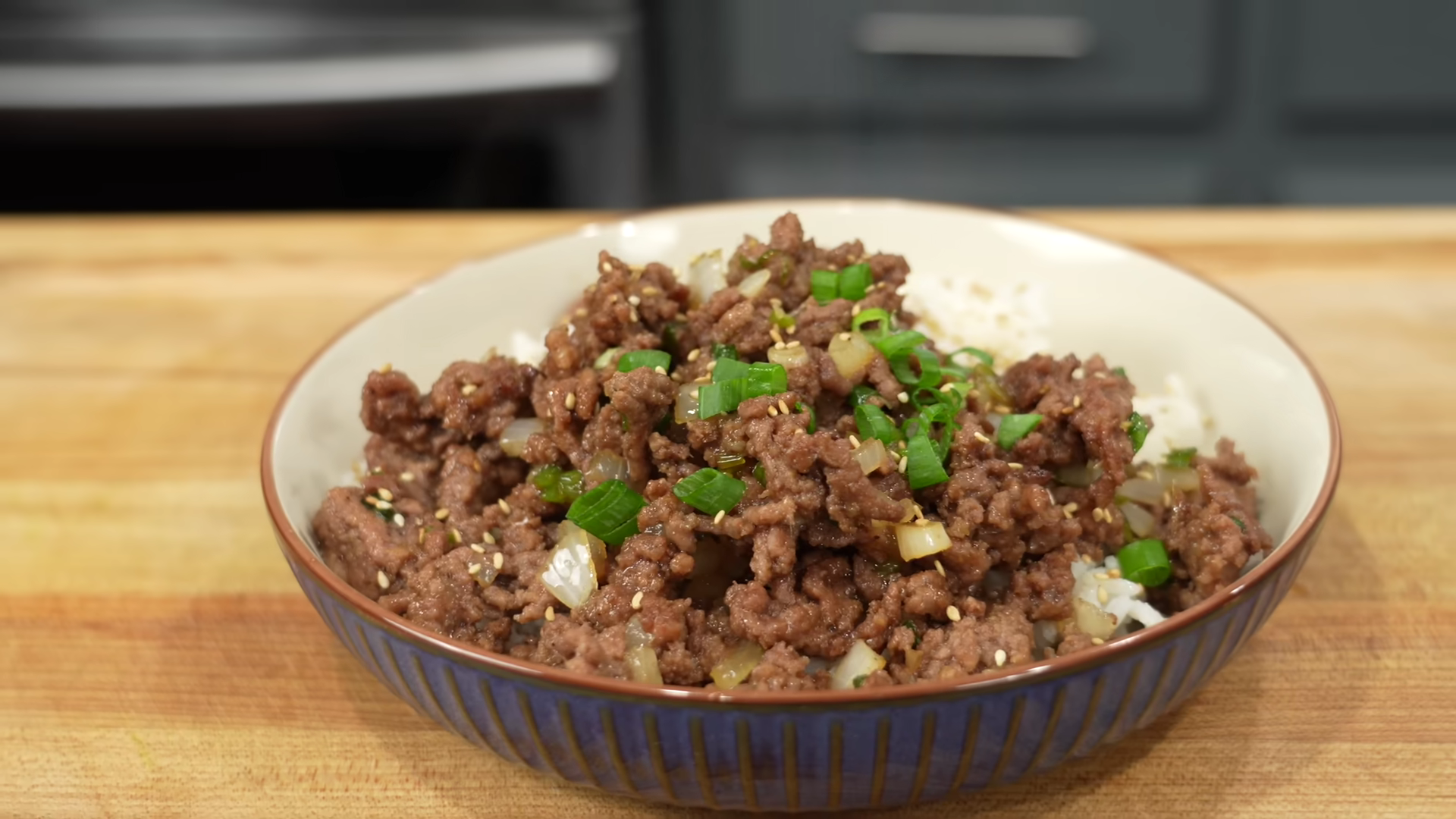Korean Beef Bowls with White Rice An Easy Weeknight Favorite Full of Flavor and Comfort
If you’re looking for a fast, flavorful dinner that combines the richness of Korean flavors with everyday pantry ingredients, you’re in for a treat. These Korean Beef Bowls with White Rice are exactly what your weeknight routine needs: comforting, satisfying, and surprisingly easy to make. Whether you’re new to Korean cuisine or just craving something bold and savory, this dish delivers in all the right ways.
Picture this: tender, savory ground beef caramelized in a soy-garlic-sesame sauce, nestled on a bed of warm, fluffy white rice, then finished with green onions and a sprinkle of sesame seeds. Every bite offers a perfect balance of sweet, salty, umami, and a touch of spice. It’s a meal that feels indulgent yet comes together in under 30 minutes — ideal for busy evenings or last-minute cravings.
This recipe is also highly customizable. You can add veggies, switch up the protein, or go low-carb by serving it over cauliflower rice. But at its core, the classic combination of seasoned beef and white rice is what makes Korean Beef Bowls such a timeless comfort dish.
Let’s dive into everything you need to make your own bowl of deliciousness.
Why You’ll Love This Korean Beef Bowl Recipe
- Quick & Easy: On the table in under 30 minutes, using one pan and minimal ingredients.
- Budget-Friendly: Uses ground beef and pantry staples — no need to visit a specialty store.
- Packed with Flavor: Sweet, salty, umami, and spicy elements come together for that bold Korean-style taste.
- Versatile: Easily adapted for gluten-free, low-carb, or veggie-packed versions.
- Meal-Prep Approved: Keeps well and reheats beautifully for lunch the next day.
Ingredients for Korean Beef Bowls with White Rice
Here’s everything you’ll need to whip up this dish. You probably already have many of these ingredients in your kitchen.
For the Beef:
- 1 pound ground beef (85% lean is perfect)
- 1 tablespoon sesame oil
- 3 cloves garlic, minced
- 1 teaspoon freshly grated ginger (optional, but highly recommended)
- 1/4 cup low-sodium soy sauce
- 2 tablespoons brown sugar
- 1 tablespoon Gochujang (Korean chili paste) or 1/2 teaspoon red pepper flakes for heat
- 1 tablespoon rice vinegar (balances the richness)
- 1 teaspoon cornstarch mixed with 2 teaspoons water (optional for thickening)
- 2 green onions, thinly sliced
- 1 tablespoon toasted sesame seeds (for garnish)
For the White Rice:
- 1 1/2 cups white jasmine rice
- 3 cups water
- Pinch of salt
Optional Add-ins and Toppings:
- Sautéed or steamed broccoli
- Shredded carrots
- Kimchi
- Fried or soft-boiled egg
- Cucumber slices
- Pickled radish
Step-by-Step Instructions
Step 1: Cook the Rice
Start by preparing the white rice. You can use a rice cooker, stovetop, or Instant Pot — whatever you prefer. Here’s how to do it on the stovetop:
- Rinse the rice under cold water until the water runs clear.
- In a medium saucepan, combine 1 1/2 cups of rinsed rice with 3 cups of water and a pinch of salt.
- Bring it to a boil over medium-high heat.
- Once boiling, reduce the heat to low, cover with a tight-fitting lid, and let simmer for 18-20 minutes.
- Turn off the heat and let it sit, covered, for 5-10 minutes before fluffing with a fork.
While the rice is cooking, move on to the beef.
Step 2: Sauté the Aromatics
- Heat 1 tablespoon of sesame oil in a large skillet over medium heat.
- Add the minced garlic and ginger and sauté for about 30 seconds to release the aroma.
Step 3: Brown the Ground Beef
- Add the ground beef to the skillet.
- Break it up with a wooden spoon or spatula.
- Cook until browned and fully cooked through, about 6-8 minutes. Drain excess fat if needed.
Step 4: Add the Sauce
- In a small bowl, mix the soy sauce, brown sugar, gochujang (or red pepper flakes), and rice vinegar.
- Pour the sauce into the skillet with the cooked beef.
- Stir well and let it simmer for 2-3 minutes so the flavors meld together.
If you want a thicker, glossy sauce, stir in the cornstarch-water slurry and cook for another minute until the sauce thickens.
Step 5: Finish with Garnishes
- Stir in half of the green onions and sesame seeds.
- Reserve the rest for garnish.
Step 6: Assemble the Bowls
- Spoon the warm white rice into bowls.
- Top with a generous scoop of the Korean beef.
- Add your favorite toppings: more green onions, sesame seeds, steamed broccoli, or a fried egg.
Tips for the Best Korean Beef Bowls
- Use fresh garlic and ginger for the best flavor — powdered versions just don’t compare.
- Don’t skip the sesame oil — it adds that authentic Korean nuttiness that ties everything together.
- Make it spicy or mild depending on your taste. Gochujang adds complexity, but you can also use red pepper flakes or sriracha.
- Customize the bowl with veggies. It’s a great way to add color, texture, and nutrition.
- Double the sauce if you want it extra juicy, especially if serving with rice that absorbs flavor quickly.
Variations You Can Try
1. Low-Carb Korean Beef Bowl
Swap out the white rice for cauliflower rice or zucchini noodles. Skip the brown sugar or replace it with a sugar substitute like monk fruit or erythritol.
2. Korean Chicken or Turkey Bowls
Ground chicken or turkey makes a lighter version of this dish without sacrificing flavor.
3. Vegetarian Korean “Beef” Bowls
Use crumbled tofu, tempeh, or a plant-based ground meat substitute like Beyond or Impossible. The sauce does all the heavy lifting for flavor.
4. Bibimbap-Inspired Bowl
Add a fried egg, sautéed spinach, bean sprouts, and pickled radish to turn your bowl into a bibimbap hybrid.
Make-Ahead and Storage Tips
This recipe is a meal-prepper’s dream.
- Refrigerator: Store the beef and rice separately in airtight containers for up to 4 days.
- Freezer: You can freeze the cooked beef for up to 3 months. Just thaw and reheat in a skillet or microwave.
- Reheating: Splash a little water or soy sauce over the beef before reheating to keep it moist.
What to Serve with Korean Beef Bowls
If you want to round out your meal, here are some delicious sides and drinks to consider:
- Side Dishes:
- Kimchi (fermented cabbage for a spicy, sour kick)
- Korean Cucumber Salad (Oi Muchim)
- Seaweed Salad
- Miso soup or egg drop soup
- Drinks:
- Iced green tea
- Korean barley tea (boricha)
- A refreshing citrus soda
Nutrition Breakdown (Per Serving, Approximate)
- Calories: 540
- Protein: 26g
- Carbohydrates: 45g
- Fat: 28g
- Fiber: 2g
- Sugar: 7g
- Sodium: 800mg
These numbers can vary depending on your rice-to-beef ratio and added toppings.
Final Thoughts
Once you try these Korean Beef Bowls with White Rice, they’ll quickly become a staple in your dinner rotation. They strike the perfect balance between ease and flavor, comfort and flair. It’s a recipe that’s hard to mess up and even harder to stop eating once you start.
The best part? You don’t need fancy ingredients or a deep knowledge of Korean cooking to make this work. With just a few pantry staples, a good skillet, and a pot of rice, you’ll have a restaurant-worthy meal right in your kitchen — no takeout required.
So, the next time you’re short on time but craving something bold and delicious, remember this recipe. Your future self (and your tastebuds) will thank you.

